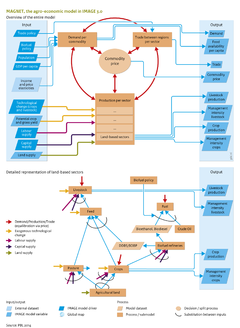Agricultural economy: Difference between revisions
Jump to navigation
Jump to search
No edit summary |
No edit summary |
||
| Line 7: | Line 7: | ||
|InputVar=Population; GDP per capita; Capital supply; Labor supply; Trade policy; Biofuel policy; Land supply; Potential crop and grass yield - grid; Technological change (crops and livestock); | |InputVar=Population; GDP per capita; Capital supply; Labor supply; Trade policy; Biofuel policy; Land supply; Potential crop and grass yield - grid; Technological change (crops and livestock); | ||
|Parameter=Income and price elasticities; | |Parameter=Income and price elasticities; | ||
|OutputVar=Management intensity crops; Management intensity livestock; Food availability per capita; Commodity price; Livestock production; Crop production; Demand (all commodities); Trade (all commodities); | |OutputVar=Management intensity crops; Management intensity livestock; Food availability per capita; Commodity price; Livestock production; Crop production; Demand (all commodities); Trade (all commodities); | ||
|Description=As a result of the growing world population and higher per capita consumption, production of food, feed, fibres and other products, such as bio-energy and timber will need to increase rapidly in the coming decades. Even with the expected improvements in agricultural yields and efficiency, there will be increasing demand for more agricultural land. However expansion of agricultural land will lead to increases in greenhouse gas emissions, loss of biodiversity and ecosystem services, and nutrient imbalances. To reduce these environmental impacts, action is needed urgently to increase agricultural yields further and to reduce deforestation requires political support. | |Description=As a result of the growing world population and higher per capita consumption, production of food, feed, fibres and other products, such as bio-energy and timber will need to increase rapidly in the coming decades. Even with the expected improvements in agricultural yields and efficiency, there will be increasing demand for more agricultural land. However expansion of agricultural land will lead to increases in greenhouse gas emissions, loss of biodiversity and ecosystem services, and nutrient imbalances. To reduce these environmental impacts, action is needed urgently to increase agricultural yields further and to reduce deforestation requires political support. | ||
| Line 19: | Line 19: | ||
In IMAGE, demand for forest products can be derived from several sources, the most simplest being via a relationship with GDP or preferably, from specific forest demand models, such as [[EFIGTM model|EFI-GTM]] ([[Kallio et al., 2004]]). In the future, competition between forestry and other land uses can be included using the forestry module in MAGNET. Other land-use changes, such as infrastructure expansion, which do not require interregional links, are described in the land-use allocation module [[Agricultural systems]]. | In IMAGE, demand for forest products can be derived from several sources, the most simplest being via a relationship with GDP or preferably, from specific forest demand models, such as [[EFIGTM model|EFI-GTM]] ([[Kallio et al., 2004]]). In the future, competition between forestry and other land uses can be included using the forestry module in MAGNET. Other land-use changes, such as infrastructure expansion, which do not require interregional links, are described in the land-use allocation module [[Agricultural systems]]. | ||
|ComponentCode=AEF | |ComponentCode=AEF | ||
|AggregatedComponent=Agriculture and land use | |AggregatedComponent=Agriculture and land use | ||
|FrameworkElementType=pressure component | |FrameworkElementType=pressure component | ||
}} | }} | ||
Revision as of 16:35, 4 April 2014
Parts of Agricultural economy
| Component is implemented in: |
|
| Related IMAGE components |
| Projects/Applications |
| Key publications |
| References |
Key policy issues
- What is the area of cropland and grassland required to support future food demand?
- What are the policy options to reduce agricultural land use and to safeguard global biodiversity, while ensuring food security?
- How can the implications of biofuels for land use and greenhouse gases be managed sustainably?
